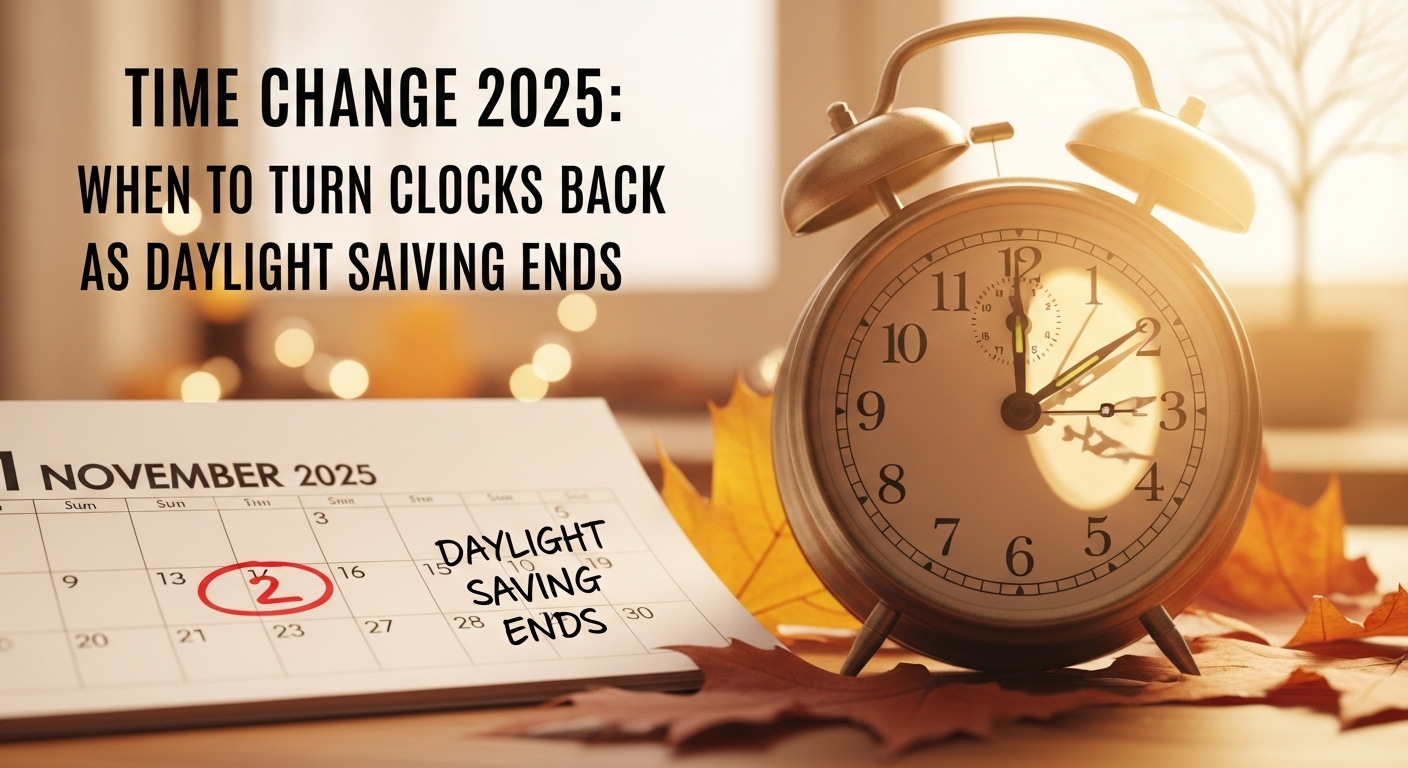When Does Daylight Saving Time End in 2025? Here’s When to Set Your Clocks Back
As the year winds down, one common question arises: when does daylight saving time end in 2025? Every fall, people across the United States, the United Kingdom, and Australia prepare for the time change in fall 2025, turning their clocks back by one hour. This annual shift marks the return to standard time, giving everyone a little extra sleep and signaling shorter, cooler days ahead.
The end of Daylight Saving Time 2025 affects not only your clocks but also daily routines, morning light, and evening darkness. Let’s break down the exact date, history, and reasons behind this yearly time adjustment.
When Does Daylight Time End in 2025?
In 2025, daylight time ends on Sunday, November 2, at 2:00 a.m.. On this day, clocks in most U.S. states “fall back” one hour, returning to standard time. This change means the sun will rise earlier in the morning and set earlier in the evening.
For those living in the United Kingdom, the time change fall 2025 happens a week earlier, on Sunday, October 26, at 2:00 a.m. British Summer Time (BST). In Australia, the switch occurs in New South Wales, Victoria, South Australia, Tasmania, and the ACT on Sunday, April 6, 2025, marking the end of their summer daylight saving period.
So wherever you are, Daylight Saving Time 2025 will bring the familiar shift that resets daily rhythms and sleep schedules.
Why Do We Observe Daylight Saving Time 2025?
The concept of daylight savings started more than a century ago as a way to make better use of natural daylight. The goal was to save energy by extending daylight into the evening during warmer months.
In Daylight Saving Time 2025, this tradition continues, helping communities enjoy longer daylight hours during spring and summer. However, once autumn arrives, returning to standard time helps align daylight with typical morning routines.
Many people appreciate the extra hour of sleep when time change fall 2025 arrives, even though the earlier sunsets can take some getting used to.
How to Prepare for the Time Change Fall 2025
When Daylight Time 2025 ends, it’s important to adjust both your schedule and devices. Most smartphones and digital clocks automatically reset, but many household items do not.
Before going to bed on Saturday, November 1, 2025, manually turn back your clocks one hour. This ensures you wake up on the correct time Sunday morning.
In addition to resetting clocks, here are a few simple steps to help adjust smoothly to the time change fall 2025:
- Go to bed earlier for a few nights leading up to the change.
- Spend time in morning sunlight to help your body’s internal clock adjust.
- Plan your schedule to include the extra hour productively.
- Check smoke detectors and replace batteries, a common safety tip tied to daylight saving time reminders.
Which Areas Do Not Observe Daylight Time 2025?
While Daylight Time 2025 is widely recognized, not every region participates. In the United States, Hawaii and most of Arizona do not observe daylight saving time. U.S. territories such as Puerto Rico, Guam, American Samoa, and the Virgin Islands also remain on standard time year-round.
Globally, many nations have ended the practice altogether. Japan, India, and most of Africa do not change their clocks. Meanwhile, several Australian states and Canadian provinces continue to debate whether the twice-yearly time change should remain in place.
The European Union has even discussed plans to abolish daylight saving altogether, though no firm decision has yet been made.
Impact of Daylight Saving Time 2025 on Daily Life
When Daylight Saving Time 2025 ends, the shift can affect sleep, productivity, and even mood. The earlier darkness can lead to reduced outdoor activity and changes in energy levels. However, the brighter mornings often help people start their days with more natural light.
In workplaces, the time change fall 2025 can influence commuting patterns, safety, and energy consumption. Adjusting gradually can help minimize disruption, especially for those sensitive to sleep schedule changes.
Parents often notice the biggest impact on children’s routines, as kids may wake up earlier and tire sooner in the evening. Families can prepare by slowly adjusting bedtime in the days leading up to the change.
Daylight Saving Time 2025 and Technology
Thanks to modern technology, most people no longer have to manually change all their clocks. Smartphones, computers, and smart home devices automatically update when Saving Time 2025 ends.
However, not all gadgets are as smart. Microwaves, wall clocks, ovens, and car dashboards often need manual updates. It’s a good idea to double-check all devices after the time change in fall 2025 to avoid any confusion.
The Debate Around Daylight Saving Time 2025
Every year, discussions about ending Daylight Time resurface. Some argue the time change disrupts sleep and offers little modern benefit, while others appreciate the extended daylight during summer months.
In recent years, several U.S. states, including Florida, Washington, and California, have proposed staying on daylight saving time permanently. However, any nationwide change would require congressional approval.
In the United Kingdom, opinions are mixed as well. Supporters of keeping the time change say it helps align business hours with daylight, while critics call it unnecessary in the digital age.
As of now, Daylight Saving Time 2025 will continue as scheduled, with millions turning clocks back this November.
How the End of Daylight Saving Time 2025 Affects Health
The time change fall 2025 can impact sleep patterns and circadian rhythms. While gaining an hour of rest may sound great, the sudden shift can temporarily affect alertness and mood.
To stay balanced during the Daylight Saving Time 2025 transition:
- Stick to a consistent bedtime routine.
- Spend time outdoors during daylight hours.
- Avoid heavy meals or caffeine close to bedtime.
- Maintain regular exercise to support healthy sleep cycles.
Most people adjust within a few days, but being mindful helps ensure the change doesn’t disrupt your daily flow.
Conclusion:
As Daylight Saving Time 2025 comes to an end, prepare to set your clocks back one hour on November 2, 2025. This small change brings brighter mornings, earlier sunsets, and that coveted extra hour of sleep.
Whether you love or dislike the adjustment, it remains a yearly ritual that connects millions around the world. With a little preparation and awareness, the time change in fall 2025 can be a smooth and refreshing transition into the cooler, cozier months ahead.
FAQs
When does daylight saving time end in 2025?
Daylight saving time ends on Sunday, November 2, 2025, at 2:00 a.m., when clocks move back one hour.
When does daylight saving time start again?
In 2026, daylight saving time will begin on Sunday, March 8, when clocks move forward one hour.
Does every state observe Daylight Saving Time 2025?
No. Hawaii, most of Arizona, and several U.S. territories do not observe daylight saving time.
Why do we turn clocks back in the fall?
We turn clocks back to return to standard time, allowing more daylight in the morning as days get shorter.
How can I adjust to the time change in fall 2025?
Start going to bed earlier, get morning sunlight, and plan ahead for the new schedule to adjust easily.
Disclaimer:
The content shared by Meyka AI PTY LTD is solely for research and informational purposes. Meyka is not a financial advisory service, and the information provided should not be considered investment or trading advice.






